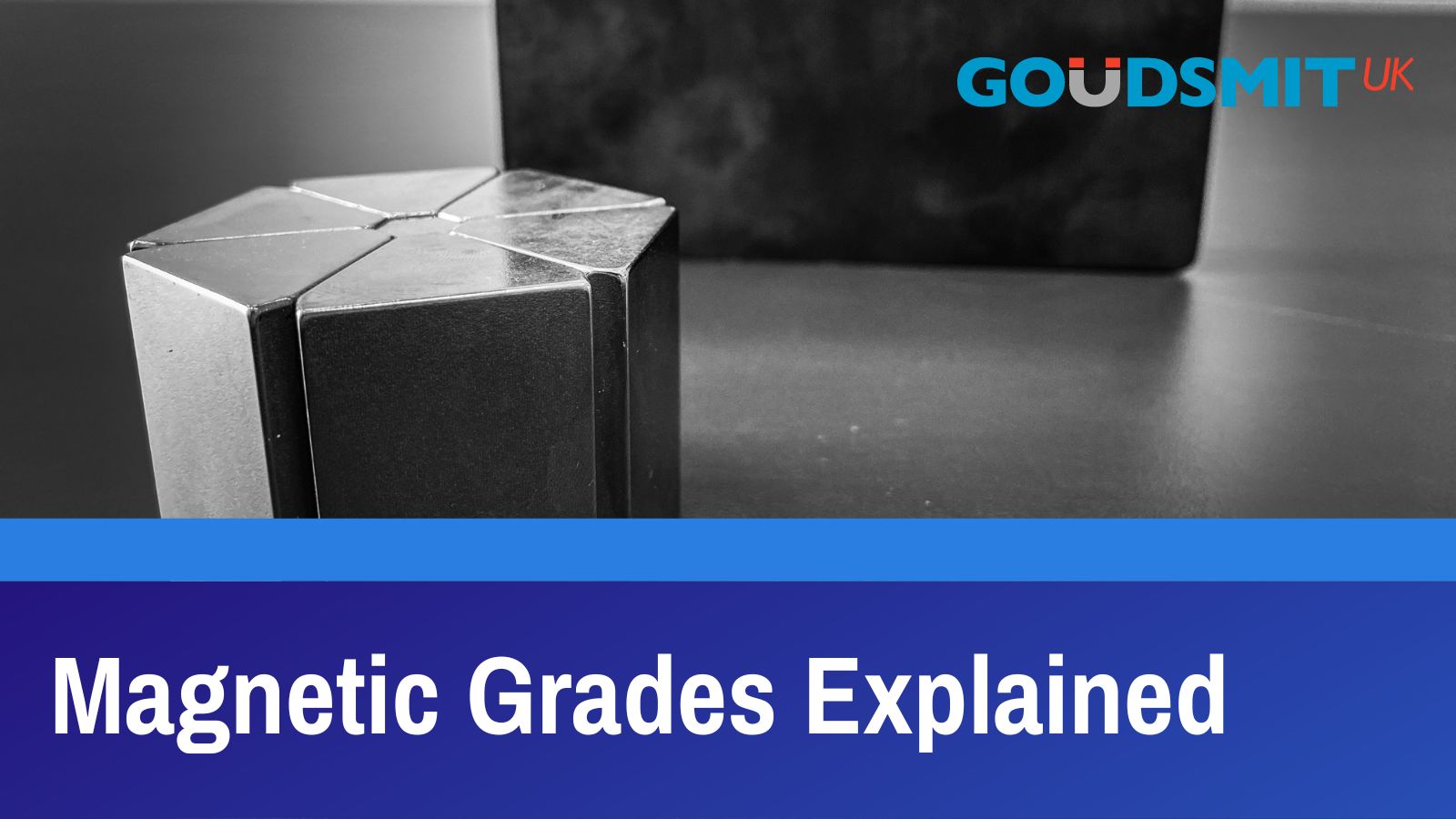Magnets are the backbone of countless industrial and technological applications, but understanding their strength and composition can be daunting.
In this guide, we demystify magnet grades and explain how you can determine which magnetic grade is most suited to your needs.
What Are Magnetic Grades?
In the simplest terms, a magnetic grade is a measure of a magnet’s strength. A higher magnetic grade typically denotes greater strength.
The number associated with each magnetic grade is derived from the Maximum Energy Product of the magnet, expressed in MGOe (Mega Gauss Oersteds), representing the strongest point in the magnet’s BH Curve. This is also known as the BH Max.
Magnetic grades serve as a crucial classification system for permanent magnets, providing essential information about their strength, composition, and performance characteristics.
For instance, with the grade N40AH, we can ascertain the material (N for Neodymium), strength (40), and the level of temperature resistance (AH – indicative of a max working temperature of 230°C). These grades guide users toward selecting the most suitable magnet for their specific application needs.
At Goudsmit UK, we provide a full range of magnetic grades to meet your application needs.
Magnetic Grading Systems
Different types of magnets have distinct grading systems. Here’s a closer look at some common magnetic materials and their grades:
Ferrite Magnets
Ferrite magnets, also known as ceramic magnets, are widely used in various applications due to their cost-effectiveness, durability, and excellent resistance to demagnetization and corrosion.
Ferrite magnets have a lower maximum energy product compared to other types of permanent magnets, ranging from 1.1 to 4.0 MGOe, depending on the specific type and manufacturing process, with ranges differing for isotropic and anisotropic ferrite.
Neodymium (NdFeB) Magnets
Neodymium magnets are the strongest permanent magnets available today, made of neodymium, iron, and boron.
Graded numerically (N35, N42, N52), higher numbers signify greater strength. Commonly used across a range of applications, Neodymium magnets offer high resistance to demagnetization and can be produced in a wide range of shapes and sizes.
You will also often see other letter gradings used at the end of each grade, such as N38M orN50SH. These letters are used to signify further properties unique to that grade, such as high temperature resistance in the case of N50SH.
Samarium Cobalt (SmCo) Magnets
Resistant to demagnetization and corrosion, Samarium Cobalt magnets excel in extreme conditions due to their temperature stability.
They are graded similarly to neodymium magnets, with higher grades offering superior performance. SmCo magnets are typically graded in the MGOe range of 16-40, indicating their relatively weaker strength compared to Neodymium magnets, which are graded in the MGOe 35-55 range. Further development in the coming years is also expected to lead to even stronger grades of Neodymium magnets.
AlNiCo Magnets
Alnico magnets are made from an alloy of aluminium, nickel, and cobalt, along with other elements like copper and iron. They are known for excellent temperature stability and high coercivity. Alnico magnets are produced through two primary methods – sintering and casting.
Cast Alnico Magnets: Produced by pouring a molten alloy of the metals into a mould, followed by heat-treatment cycles. This method allows for larger sizes and complex shapes. Cast Alnico is available from Grades Alnico 2 – Alnico 9.
Sintered Alnico Magnets: Created by pressing mixed metal powders into shape, then sintering at high temperatures. Suitable for smaller, intricate shapes with tight dimensional tolerances. Sintered Alnico is available from Grades Alnico 2 – Alnico 8.
Both types come in anisotropic and isotropic variations. Anisotropic Alnico magnets have aligned magnetic domains for higher directional strength, while isotropic Alnico magnets have randomly oriented domains, allowing magnetization in any direction but with generally lower magnetic performance.
How to Choose a Magnetic Grade
Selecting the appropriate magnetic grade is essential for achieving the desired performance and reliability in your projects. Whether you’re working on applications requiring strong holding power, specific environmental conditions, or particular size constraints, these are they key factors to consider.
Assess Application Needs
When choosing a magnetic grade, start by assessing the application needs. Identify the magnet’s purpose: for applications requiring strong holding power, high-grade Neodymium magnets like N52 are often preferred due to their superior strength. For applications involving sensors or reed switches, lower strength but specific characteristics might be needed, making Samarium Cobalt or Alnico magnets suitable. Determine the required magnetic strength by assessing the needed field strength and selecting a grade that meets or exceeds this need. High coercivity magnets, such as Neodymium and Samarium Cobalt, are essential for environments prone to demagnetizing influences.
Consider Environmental Factors
Next, consider environmental factors. For high-temperature applications, Samarium Cobalt and certain Alnico grades are more stable, although Neodymium magnets with temperature-resistant grades (e.g., N40AH) can also be used. In corrosive environments, Ferrite and Samarium Cobalt magnets are highly resistant to corrosion, making them ideal for humid or corrosive conditions. Neodymium magnets can have protective coatings, like nickel or epoxy, to enhance corrosion resistance.
Evaluate Size and Shape Constraints
Evaluate size and shape constraints by considering space availability and magnet shape. Neodymium magnets, with their high energy product, are suitable for applications with limited space. For complex shapes, sintered Alnico and Ferrite magnets can be produced in intricate forms, while cast magnets allow for larger and more complex geometries. Sintered magnets generally offer tighter dimensional tolerances compared to cast magnets.
Budget Considerations
Finally, take budget considerations into account. For high-performance applications, Neodymium and Samarium Cobalt magnets, although more expensive, offer superior performance. For cost-sensitive projects, Ferrite magnets are cost-effective and suitable where budget constraints are paramount. Consider the long-term value by assessing the durability and potential cost savings of using higher-quality magnets that offer greater durability and stability.
Goudsmit UK
Goudsmit UK empowers you to navigate magnetic grades confidently. By unravelling complexities, we facilitate innovation across industries.
Let Goudsmit UK be your guide in unlocking the power of magnets. Contact us today to learn how we can help meet your magnet needs.







